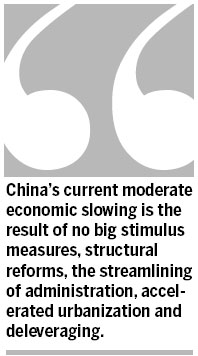Confidence in Chinese economy

Restructuring and releasing domestic demand will ensure the country maintains sustainable and balanced growth
It used to be said that if the United States sneezed, the rest of the world caught a cold. However the influence of the US economy on the global economy seems to be waning, as the US slowdown has had little discernible effect on growth in most other countries, except its neighbors, Canada and Mexico. The conclusion is that the spillover effects of the US' economic slowdown are limited and the global economy in the future might decouple from the US economy.
It has also been said that in the 1990s, whenever the world caught a cold, emerging markets got pneumonia. But when the G7 economies got pneumonia in 2008, emerging economies just caught a cold. When the US sub-prime mortgage crisis developed into a global financial crisis, emerging economies, without exception, were subject to the impact of this financial tsunami, however, the intensity was less than expected. Through introducing large-scale stimulus plans, emerging economies realized recovery in a relatively short period of time.
Recently, however, thanks to the cyclical changes of primary product prices in the world market, the sluggish US economy and the European debt crisis and other adverse factors, economic growth in emerging economies has slowed and there is growing concern about the growth prospects of emerging economies, after a decade of surging growth, in which they have led a global boom and then helped pull the world economy forward in the face of the financial crisis.
The slowing of China's economic growth in the largest emerging market and the world's second-largest economy has aroused worldwide concern. People are asking whether China's economic slowdown will result in a hard landing, and whether the government's reform program will be derailed by complex social problems, will the China model become synonymous with failure, will the global economy slow even more due to China's economic malaise?
However, people should have confidence in China's economic growth.
The current slowdown in China's economic growth is the result of the country's efforts to transform its economic growth pattern. After more than 30 years of high growth, China can no longer afford to continue with its old development model of high consumption and high investment. It must find a balance between steady growth, structural readjustment and further reform.
Since taking office in March, the new Chinese leadership has made the pursuit of steady growth, improvement of people's livelihoods and the promotion of social fairness its policy priorities. China's current moderate economic slowing is the result of no big stimulus measures, structural reforms, the streamlining of administration, accelerated urbanization and deleveraging.
China's economic fundamentals are strong, as its 7.6 percent GDP annual growth in the first half of this year shows. China is facing new challenges, such as local government debt and overcapacity in some industries, but these problems are still manageable. In addition, both the 5 percent surveyed unemployment rate and 2.4 percent inflation rate are reasonable and manageable.
In fact, in order to prevent excessive fluctuations in economic growth, the Chinese government has defined upper and lower limits for the country's economic performance. The upper limit is meant to prevent inflation and the lower limit is intended to ensure steady growth and employment.
The government has and will continue to adopt a variety of measures to avoid a hard landing. For example, it will continue to advance reforms of the fiscal and tax systems, financial sector and pricing and further streamline government and delegate power, develop a mixed ownership economy and strengthen innovation.



















